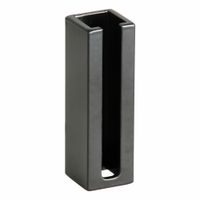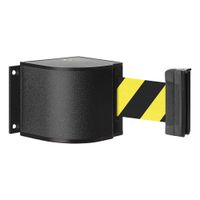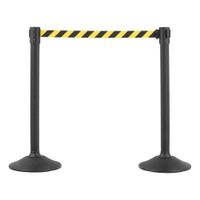Call +(254) 703 030 000 / 751 483 999 / 721 704 777
- Home
- Security
- Access Barriers Crowd Control
- Retractable Belt Barriers
.....Read More
Frequently Asked Questions
What are retractable belt barriers used for?
Retractable belt barriers are versatile crowd control tools used to manage and direct pedestrian traffic in various settings. They consist of a sturdy post with a retractable belt that can be extended and connected to another post or wall receiver, forming a temporary barrier. These barriers are commonly used in airports, banks, retail stores, museums, and event venues to organize queues, prevent overcrowding, and enhance safety.
In airports, retractable belt barriers help streamline passenger flow through security checkpoints, boarding areas, and customs, reducing congestion and improving efficiency. In retail environments, they guide customers through checkout lines, ensuring orderly service and minimizing wait times. Museums and galleries use them to control access to exhibits, protecting valuable artifacts and providing a clear path for visitors.
Event organizers deploy retractable belt barriers to delineate VIP areas, manage entry and exit points, and create designated pathways, ensuring smooth operations and enhancing the attendee experience. In corporate settings, they are used to cordon off restricted areas, maintain privacy, and direct foot traffic during conferences or meetings.
Additionally, retractable belt barriers are employed in safety and emergency situations to block off hazardous areas, guide evacuations, and maintain order during drills or real emergencies. Their portability and ease of setup make them ideal for temporary use, while their durability ensures they withstand frequent handling and outdoor conditions.
Overall, retractable belt barriers are essential tools for maintaining order, enhancing safety, and improving the flow of people in various environments, making them indispensable in both everyday operations and special events.
How do retractable belt barriers work?
Retractable belt barriers are crowd control tools used to manage queues and direct pedestrian traffic. They consist of a sturdy post, often made of metal or durable plastic, with a retractable belt housed within a cassette at the top of the post. The belt is typically made of durable fabric or synthetic material and can extend several feet.
The mechanism works as follows:
1. **Post and Base**: The post is mounted on a stable base to prevent tipping. The base is often weighted or designed to be wide enough to provide stability.
2. **Retractable Belt Cassette**: At the top of the post is a cassette containing the coiled belt. The belt is spring-loaded, allowing it to retract smoothly back into the cassette when not in use.
3. **Belt Extension and Locking**: To use the barrier, the belt is pulled out from the cassette and extended to the desired length. The end of the belt has a connector, usually a clip or hook, which attaches to a receiving slot on another post or wall-mounted unit. This connection locks the belt in place, creating a barrier.
4. **Tension Mechanism**: The belt is kept taut by the tension mechanism within the cassette, ensuring it remains straight and effective as a barrier.
5. **Safety Features**: Many retractable belt barriers include safety features such as slow-retraction mechanisms to prevent the belt from snapping back quickly, reducing the risk of injury.
6. **Customization**: The belts can be customized with different colors, patterns, or logos for branding or to convey specific messages.
These barriers are versatile, easy to set up, and can be quickly reconfigured to adapt to changing crowd control needs, making them ideal for airports, banks, museums, and other public spaces.
What are the benefits of using retractable belt barriers?
Retractable belt barriers offer several benefits, making them a popular choice for crowd control and queue management:
1. **Flexibility and Versatility**: These barriers can be easily adjusted to fit various spaces and configurations, making them suitable for different environments such as airports, banks, retail stores, and event venues.
2. **Space Efficiency**: When not in use, the belts retract into the posts, saving space and allowing for easy storage. This feature is particularly beneficial in areas with limited space.
3. **Quick Deployment**: The retractable mechanism allows for rapid setup and takedown, enabling efficient management of crowds and queues without extensive preparation time.
4. **Safety**: The belts are designed to prevent tripping hazards and are often made from durable materials that can withstand pressure, reducing the risk of accidents in crowded areas.
5. **Customizability**: Many retractable belt barriers offer options for custom branding or messaging on the belts, providing an opportunity for businesses to communicate with customers or reinforce brand identity.
6. **Durability**: Constructed from robust materials, these barriers are designed to withstand frequent use and harsh conditions, ensuring longevity and reducing replacement costs.
7. **Aesthetic Appeal**: Available in various colors and finishes, retractable belt barriers can complement the decor of any setting, enhancing the overall appearance of the space.
8. **Cost-Effectiveness**: Compared to permanent barriers, retractable belt barriers are a more affordable solution for temporary crowd control needs, offering a good return on investment.
9. **Enhanced Crowd Management**: They help organize and direct foot traffic efficiently, minimizing confusion and improving the flow of people in busy areas.
10. **Portability**: Lightweight and easy to move, these barriers can be relocated as needed, providing flexibility in managing different events or changing layouts.
How do you install a wall-mounted retractable belt barrier?
1. **Select Location**: Choose a suitable location on the wall where the retractable belt barrier will be installed. Ensure it is at a height that is easily accessible and visible.
2. **Gather Tools and Materials**: You will need a drill, screws, wall anchors (if mounting on drywall), a screwdriver, a level, a measuring tape, and a pencil.
3. **Mark the Mounting Points**: Use the measuring tape to determine the exact position for the barrier. Hold the barrier unit against the wall and use the level to ensure it is straight. Mark the screw holes with a pencil.
4. **Drill Holes**: If mounting on drywall, drill holes at the marked points and insert wall anchors to provide extra support. For solid walls, simply drill holes that match the size of the screws.
5. **Attach the Mounting Bracket**: Align the mounting bracket with the drilled holes. Use the screwdriver to secure the bracket to the wall with screws. Ensure it is tightly fastened.
6. **Install the Retractable Unit**: Attach the retractable belt unit to the mounted bracket. This usually involves sliding the unit onto the bracket or securing it with additional screws, depending on the model.
7. **Install the Receiving End**: Determine where the belt will extend to and mark the location for the receiving end. Repeat the drilling and anchoring process to install the receiving bracket or clip.
8. **Test the Barrier**: Pull the belt across to the receiving end to ensure it extends and retracts smoothly. Make any necessary adjustments to the alignment or tension.
9. **Final Check**: Ensure all components are securely fastened and the belt operates correctly. Make any final adjustments for optimal performance.
What is the difference between retractable belt post barriers and receiver posts?
Retractable belt post barriers and receiver posts are both used for crowd control and queue management, but they serve slightly different purposes and have distinct features.
Retractable Belt Post Barriers:
1. **Functionality**: These posts come with a retractable belt mechanism. The belt can be extended and connected to another post to form a barrier or queue line.
2. **Flexibility**: The retractable belt allows for easy adjustment of the barrier length, making it versatile for different space requirements.
3. **Mobility**: They are often portable, allowing for quick setup and reconfiguration as needed.
4. **Visibility**: The belts are usually available in various colors and can include printed messages or logos for better visibility and communication.
5. **Applications**: Commonly used in airports, banks, museums, and other public venues where temporary or adjustable barriers are needed.
Receiver Posts:
1. **Functionality**: Receiver posts are designed to receive the end of a retractable belt from another post. They do not have a belt of their own.
2. **Stability**: Typically used as a fixed point in a barrier system, providing a stable endpoint for the belt.
3. **Installation**: They can be either portable or fixed to the ground, depending on the requirement of the space.
4. **Purpose**: Primarily used to complete a barrier system where one end of the belt needs to be anchored securely.
5. **Applications**: Ideal for areas where a permanent or semi-permanent barrier is needed, such as entrances or exits.
In summary, retractable belt post barriers are versatile and adjustable, suitable for dynamic environments, while receiver posts provide a stable endpoint for these systems, often used in more permanent setups.
How long can the belt in a retractable belt barrier extend?
The length of the belt in a retractable belt barrier can vary depending on the manufacturer and the specific model. However, most standard retractable belt barriers typically extend between 6 to 11 feet (approximately 1.8 to 3.4 meters). Some models designed for larger spaces or specific applications can extend up to 15 feet (about 4.6 meters) or more. The length is determined by the intended use, with longer belts suitable for larger areas or where fewer stanchions are desired to cover a given distance.
Are retractable belt barriers suitable for outdoor use?
Retractable belt barriers can be suitable for outdoor use, but several factors need to be considered to ensure their effectiveness and longevity.
1. **Material Durability**: Outdoor retractable belt barriers should be made from weather-resistant materials. Stainless steel or heavy-duty plastic casings are ideal as they resist rust and corrosion. The belts themselves should be made from UV-resistant fabric to prevent fading and degradation from sun exposure.
2. **Base Stability**: Outdoor environments can be windy, so the base of the barrier must be heavy enough to prevent tipping. Weighted bases or options to secure the base to the ground are recommended to ensure stability.
3. **Weather Conditions**: Consider the typical weather conditions of the area. In regions with extreme weather, such as heavy rain, snow, or high winds, additional precautions or more robust models may be necessary. Some barriers come with water-fillable bases for added weight and stability.
4. **Portability and Storage**: If the barriers need to be moved frequently, ensure they are easy to transport and store. Some models are designed to be stackable or have wheels for easier mobility.
5. **Maintenance**: Regular maintenance is crucial for outdoor use. Check for signs of wear and tear, such as rust or belt fraying, and clean the barriers to remove dirt and debris that can accumulate outdoors.
6. **Visibility**: For safety and effectiveness, the belts should be brightly colored or have reflective strips to ensure they are visible in various lighting conditions.
In summary, while retractable belt barriers can be suitable for outdoor use, selecting the right materials, ensuring stability, and performing regular maintenance are key to their successful application in outdoor settings.




